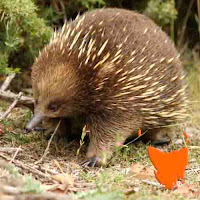 |
| VIDEO LINK |
THE Echidna (Tachyglossus aculeatus) on the kanamalukaTAMAR is not a rarity. The short-beaked echidna is one of four living species of echidna and the only member of the genus Tachyglossus. It is covered in fur and spines and has a distinctive snout and a specialised tongue, which it uses to catch its insect prey at a great speed. Like the other extant monotremes, the short-beaked echidna lays eggs; the monotremes are the only living group of mammals to do so.
It is pleasing to be able to say that if you keep a eye out almost anywhere in the kanamalukaTAMAR catchment you might well come across one. People living near the Cataract Gorge between May and September have seen an 'echidna mating train' where the males locate and pursue females. Trains of up to 10 males have been reported elsewhere, with the youngest and smallest male at the end of the queue, and they may follow a single female in a courtship ritual for up to four weeks. During this time, they forage for food together, and the train often changes composition. In Tasmania, females may mate within a few hours of arousal from hibernation.
Echidnas are known to feast on 'Jack Jumper Ants' which makes echidnas a welcome visitor in many suburban gardens. They are also the kind of visitor children like as they do not run away and anytime they feel threatened they will dig in until the danger passes. Presumably, they do this if fire comes upon them. If you attempt to dig one out you will need to be both strong and persistent. Interestingly they are also very good swimmers.
George Augustus Robinson reported that on Tasmanian Aboriginal people traveling with him roasting and eating an echidna. Within Launceston's palawa/pakana community there are stories of their Elders eating echidnas or 'porkypines' in their vernacular. The story goes that they taste like pork. This is totally unsurprising given that anthropologists working with indigenous people elsewhere report the same and that echidna figures in various communities' diets – and significantly.
TALK2TAMMYg ... LAUNYnaturalscience reference




No comments:
Post a Comment